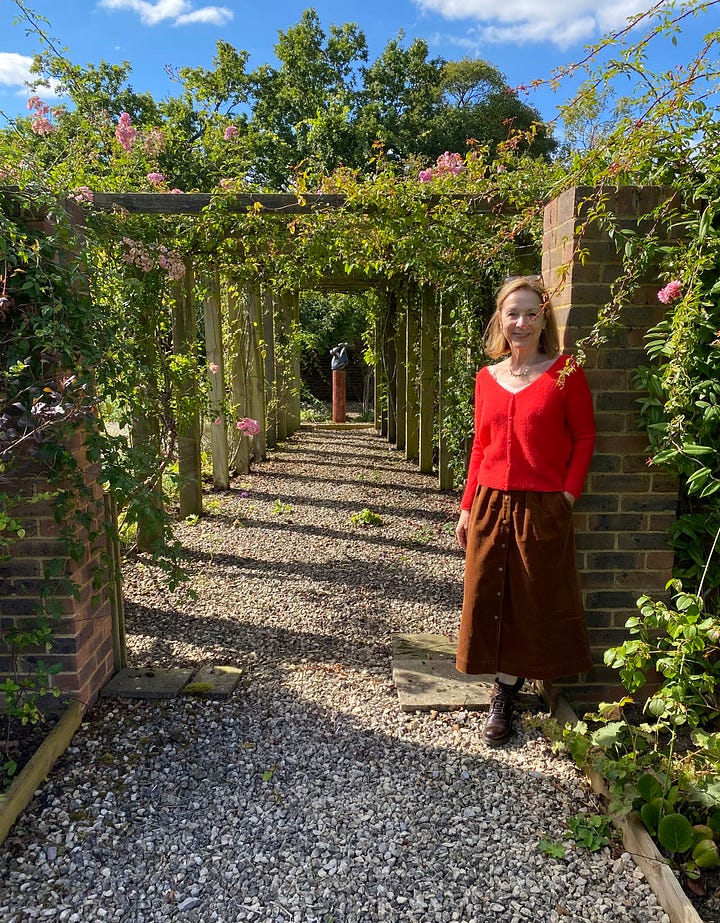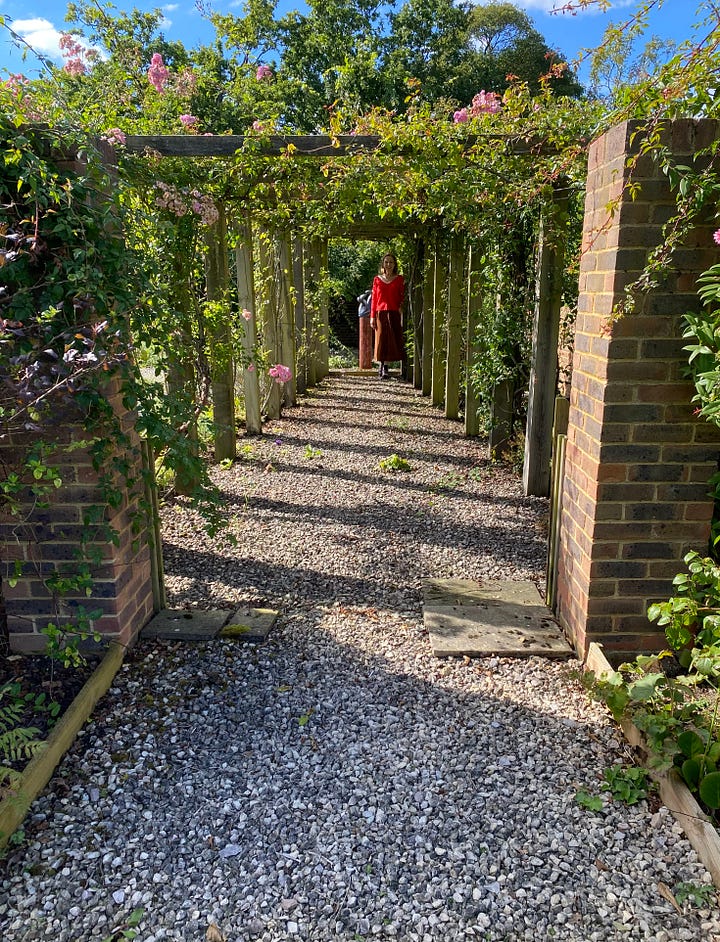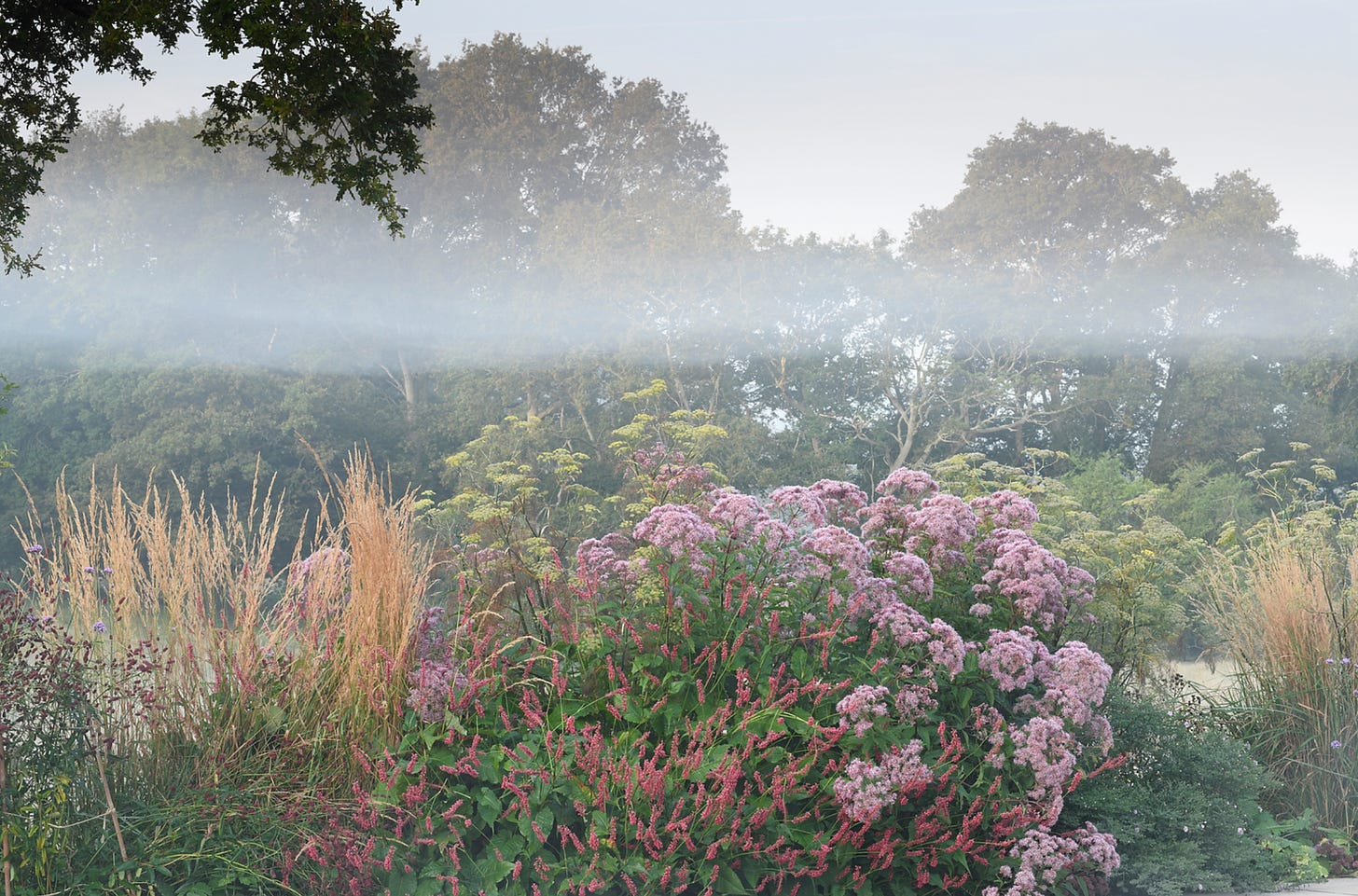Gardening in autumn - a new mindset
Plus: a bindweed revelation, an easy September pot planting, fun in the garden and a design trick, a spring bulbs cheat sheet, and the next Ask Me Anything Gardener’s Question Time
What’s coming up in this week’s Gardening Mind:
Think of the games you’ve played, the times you’ve run barefoot on the grass, children kicking a ball, toddlers precariously figuring out roly-polies which graduate into handstands and cartwheels. Spending time outside with friends. Laughing. Picnics.
Septemberish
Tomorrow is officially the first day of autumn, and at least for some of us, a few warm days have made the run-up to it a little more bearable. I’m convinced it’s to do with when you were born: my mum was born in October and she loves the autumn. As a summer baby, just the thought of leaves turning brown makes me shiver. I’m the first one to grumble at the thought of summer’s last hurrah.
I’m all about the summer, and warmth. But after 50 years of trying to ignore the fact that the season is ending, this year, I’m going to try something different.
It’s finally dawned on me that dreading the onset of autumn won’t make it go away, so I’m going to try to embrace it instead, making the most of each autumnal thing that we do. And the garden is full of those opportunities.
I’m starting off with one prong of this new approach which you might say is a bit wishy-washy, but which I’m determined is going to underline the way I garden this autumn. Not so much a resolution as a reframing, the plan is to jolly well enjoy each task for what it is. And I’m starting off with trying to ‘stay present’ - basically, enjoying whatever grim task I’m doing rather than just wondering when I can go inside and have a cup of tea.
This is all very easy to write as the sun shines - let’s see if I can stick to it. I know I find it pretty easy to get lost in meditative tasks like weeding, which I can put off for days but then, when I actually get out there, become totally absorbed in the process. We know gardening makes us feel better, but I’m the first one to avoid a task that involves me getting cold/wet/muddy, so will I actually stick to this new approach, enjoying the smell of soil and the crunch of leaves on a colder day when I’m wading about wrestling with a rose in the pouring rain? Watch this space.
Anyone going to try this with me?
If you’re new to The Gardening Mind, a huge welcome to you and I’m hoping you’ll decide to stay, becoming part of the very best online gardening community there is. It’s the best due to you all, taking part so enthusiastically, supporting, commenting and liking, chatting with each other and suggesting ideas. That really IS a community of friends.
There’s a lot to chew over and think about in this issue, and there’s something for every level of gardener.
Today, as part of the Container Planting series, we’re going to be looking at a really simple potful of plants, which requires just the tiniest bit of effort to create the cheeriest of effects in your garden
I’ve got a GEM of a nugget of information about dealing with bindweed which I can’t wait to hear your opinions on
There’s a daft design trick which might actually come in useful
This Sunday 22nd at 9am UK I’m going to be going LIVE right here on Substack, to coincide with Show Us Your Plots (see below), with another Ask Me Anything Gardener’s Question Time. If you have a question you’d like me to answer, please can you post it here? I always say this: no garden-related question is too silly, so do let me know, and I’ll try to deal with as many as I can on the day:
Here’s the weekly reminder about this week’s Show Us Your Plots on the Chat- and I can’t wait to see what’s going on in your garden. Start planning your photos - look out for the Chat thread which starts:
“It’s Sunday 22nd September and it’s time to SHOW US YOUR PLOTS! This is our weekly get-together on this Chat thread where we show each other unfiltered, unedited photos of our real gardens or gardening space, wherever we are in the world. Tell us where you are in the world and what’s going on in your garden.”
If you haven’t used the Chat before, think of it as our very own WhatsApp group. Have a play-about with making comments and uploading photos - it’s fun, and everyone’s very welcoming. Each week it gets bigger and better, so come and join in - it’s even easier now to follow the many gardens and comments from all over the world and there’s a note on how to do this at the end of this post.
And last, but very definitely not least:
We’ve also got a new Zoom date to discuss this year’s Small Garden Design Course. I’ll be running the course in a new way, and I’m going to be providing the Zoom dates right at the beginning of the course so that you can book them in. This course is for paid subscribers, and I promise you, you get A LOT for your annual subscription.
commented this week “You are the most incredibly bang-for-buck newsletter I subscribe to” (thank you, India) - I want to share everything I know, and I want you to feel you’re getting value for money.
What is The Gardening Mind all about?
If you’re wondering whether The Gardening Mind is for you, I’ve brought together just some of the things that take place here. It’s a worldwide community of garden-lovers - we’ve got members in 156 countries and 50 US states.
Think of The Gardening as a sort of interactive gardening magazine
🌱 There are short courses to follow along with, such as Small Garden Design and Design Your Border Planting. These courses are accompanied by optional Zooms.
🌱 There are how-to tips and tricks for new gardeners. If you’re new to gardening, or you’re just pondering about dipping a toe into it, then an extra big hello and welcome to you. You might like to explore the How to Garden Series here
🌱 There are easy plant shopping lists to take the headaches away
🌱There’s a series on Garden Design Challenges, where subscribers describe their garden problems and I create a solution. Recent features include dealing with sloping gardens, how to create privacy in an overlooked garden, what to do with shady gardens, and how to transform a triangular garden
🌱We have Gardener’s Question Times and Ask Me Anythings - put a note in your diary for this Sunday’s session
🌱We have Zooms on how to find your way around The Gardening Mind, and general catch-ups
🌱We have real-life meet-ups - we’re going to have a couple in the US next year, as well as some more in the UK
🌱There are design case studies and ideas - all relevant to whatever level of gardener you are
🌱Did you get fed up with watering your pots? There are drought-tolerant container planting ideas, as well as a monthly pot planting design - September’s pot planting design is coming today
🌱And of course, there’s the usual ‘What to do in your garden this month’ feature, as well as the original ‘What NOT to do in your garden this month’
🌱There’s show garden news - in Zooms and notes and chat, we’ve followed, in real time, the actual design -not just the build -of a show garden
🌱 The ‘Digging Around’ interviews are special peeks into the gardens of fellow Substackers including India Knight Tom Cox Mark Diacono Farrah @Substack Leyla Kazim
- in the magical world of Substack, Leyla’s garden was spotted by a TV researcher, and it appeared on the actual BBC Gardener’s World this week🌱There are book giveaways, event giveaways - and, most importantly, NO paid ads or percentages taken or anything like that
🌱 All the latest news appears in The Gardening Mind before anywhere else - I announced my new book right here
If I’ve missed out anything, or if you’ve got a garden challenge/question you’d like me to cover in The Gardening Mind, please do let me know
I’m hoping that’s good value.
Let’s kick off today’s post with a design trick
This week, I went to visit a garden I designed some 15 years ago now. When I first visited this space, it was just a large, empty field; you can read about how I designed this space and made it into a garden in the case study here.
One of the areas that I had a lot of fun with was the creation of a whole new walled garden, where there was carte blanche to do pretty much whatever I liked - can you imagine the excitement?
This is where a designer needs to just stop and check themselves: the temptation is to take everything just a bit too seriously. Have you ever read about a garden in a glossy magazine and marvelled at its beauty, but at the same time you just can’t help feeling that that there’s a certain something missing? That ‘something’ often can’t be pinpointed, but it’s often to do with the lack of a bit of life, a hint of quirkiness. A bit of fun.
An element of fun in the garden is a wonderful thing. Magic and fun, the highest of compliments that can be paid to any garden1. if I’m given the opportunity, I’ll inject a bit of fun into a garden. It doesn’t need to be anything too obvious, and sometimes it can be completely pointless, apart from making people smile, or stop and puzzle.
Think of the games you’ve played, the times you’ve run barefoot on the grass, children kicking a ball, toddlers precariously figuring out roly-polies which graduate into handstands and cartwheels. Spending time outside with friends. Laughing. Picnics.
All of these and more are wrapped up into the design of any garden I’m lucky enough to work on, and sometimes, a client allows you to pick up a silly idea, and run with it. These clients, still clients today and most importantly friends, indulged me and my imagination, and let me play about with this idea in a corner of this large new walled garden which needed a bit of something fun going on in order to stop it being just another walled garden in another big garden of another big house. Rather than showing off, I wanted them to have their own element of play.
The area for the walled garden was big - it had to be big in order to fit into its spot, and also to avoid being just another design construct shoved into a corner to tick a box. This intended retreat should have space and a journey within it, in order to make sense in my own mind, and with the garden as a whole. There was a necessity for a destination within itself, and why shouldn’t that destination be a bit of fun, a folly, a surprise with an injection of amusement?
An idea I’d seen in a Roman palace visited long ago came to mind, and I presented the idea to the clients.
We built a pergola, and here I am years later: take a look at me at the front and then that statue at the very far end:
It’s a long timber walkway, still with a sprinkling of roses in September - just imagine how smothered it is with flowers and foliage in June.
The eye travels down to that large sculpture of two birds at the end of the pergola.
Now take a look at this:
Did it get you? Even for a moment? That 30 metre length is actually only 5 metres in reality.
What is the point of this? Absolutely no point apart from fun. Is it Design For Design’s Sake?2 I don’t think so - because it isn’t meant to be taken seriously, it falls into a different category.
The clients loved the ridiculousness of it all, that all-important silliness. The maths was mind-blowing as I tried to figure it out from Borromini’s plans which you can read more about here, and as we certainly couldn’t run to the travertine or marble of the original, we created a version of our own in timber.
It was just a bit of fun.


Faking the perspective
As well as being a folly, what this shows you is how you can play with perspective in the garden. This is one of the things I’m going to be looking at with you in the small garden design series. If you have a small garden which you want to make feel a little bigger, there are ways you can play with perspective:
By staggering the size and placement of trees, which will create an illusion. By placing larger plants or trees at the front of the area and progressively smaller plants toward the back, you create a sense of depth.
You can also get the same effect by narrowing a pathway, or even by using staggered stepping stones that actually converge in the distance (think railway tracks), leading the eye to a focal point.
Colour creates different effects too - using cool-toned plants (especially pale blue) or lighter-coloured materials toward the back of a space also helps magic up this sense of distance, creating a visual illusion of a bigger space.
What do you think - is playing about with perspective worth considering for your own small garden, or small garden corner? If you’re thinking of joining in the small garden design course, just make a mental note of this idea and have a think about it when you’re in your garden. Are those orange flowers making the eye zoom towards them? Have you got some big pots at the far end of the garden and small pots nearer to you - could you try swapping them round?
As I say, just bear it in mind - we’ll look all this and more during the course.
Bindweed - the revelation
I really hate bindweed - are you with me? You have a beautiful flowerbed, you’re standing there admiring the results of your labours, and then you just catch glimpse of a heart-shaped leaf that definitely doesn’t belong. Somehow, the bindweed has sneaked in and stealthily made its way up to the top of one plant and is merrily making its way across to others, in its plan to smother everything it can reach.

This week I was chatting with Sheila Das, garden manager at RHS Wisley, as we looked at a bindweed-infested bed (not at Wisley). The garden owner was understandably bemoaning the constant battle against bindweed, explaining how they carefully dig it up on a regular basis, removing as much of the root as possible, then disposing of it so that it doesn’t contaminate anything else.
I reflected that years ago, I gave up the battle AGAINST bindweed, deciding that too much of my emotional battery was being wasted on a non-human thing that I really did take personally every time I caught it sneakily creeping up an innocent plant. You might be familiar with that feeling. So I’d taken the decision to give up on the digging, and instead, I would simply keep on top of it and pull the bindweed out. And so that’s what I did.
I was reminded of this as we stood there, and told Sheila about it - imagine my














